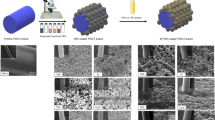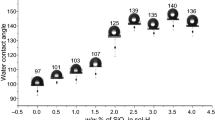Abstract
The infections give rise to a range of clinical problems and prolong hospitalization with increased healthcare costs. Moreover, persistent infections exasperate the problem of antibiotic resistance. The aim of this study was the development of effective and low-cost antibacterial silver coatings on surgical sutures by adopting an innovative photochemical deposition process to prevent early contamination of surgical wounds. The silver deposition technology adopted in this work is an innovative process based on the in situ photoreduction of a silver solution. The samples were dipped in the silver solution and then exposed to UV radiation in order to induce the synthesis of silver clusters on the surface of the suture. The homogeneous distribution of silver particles on the surface and on the cross-section of the treated sutures was demonstrated. All the antibacterial studies clearly demonstrated that the use of novel silver treated sutures could represent clinical advantages in terms of the prevention of surgical infections against bacterial colonization. The silver coating deposited on the sutures demonstrated no cytotoxic effect on a selected cell population. The results obtained suggested that the antibacterial silver-coated sutures developed in this work could represent an interesting alternative to conventional sutures, with evident advantages in terms of prevention of the surgical infections and on the health costs. In addiction, very low concentrations of silver significantly inhibited the microbial load, without affecting the cell viability.





Similar content being viewed by others
References
Huang L, Taylor H, Gerber M, Orndorff PE, Horton JR, Tonelli A. Formation of antibiotic, biodegradable/bioabsorbable polymers by processing with neomycin sulfate and its inclusion compound with β-cyclodextrin. J Appl Polym Sci. 1999;74:937–47.
Greenberg JA, Clark RM. Advances in suture material for obstetric and gynecologic surgery. Rev Obstet Gynecol. 2009;2(3):146–58.
Khiste SV, Ranganath V, Nichani AS. Evaluation of tensile strength of surgical synthetic absorbable suture materials: an in vitro study. J Periodontal Implant Sci. 2013;43:130–5.
Greenwald D, Shumway S, Albear P, Gottlieb L. Mechanical comparison of 10 suture materials before and after in vivo incubation. J Surg Res. 1994;56:372–7.
Yaltirik M, Dedeoglu K, Bilgic B, Koray M, Ersev H, Issever H. Comparison of four different suture materials in soft tissues of rats. Oral Dis. 2003;9(6):284–6.
Smith JW, Aston SJ. Grap & Smith’s plastic surgery. Boston: Little Brown; 1991. p. 13.
Dahlke H, Dociu N, Thurau K. Thrombogenicity of different suture materials as revealed by scanning electron microscopy. J Biomed Mater Res. 1980;14:251–68.
Elek SD, Conen PE. The virulence of Staphylococcus pyogenes for man. A study of the problems of wound infection. Br J Exp Pathol. 1957;38:573–86.
Kudur MH, Pai SB, Sripathi H, Prabhu S. Sutures and suturing techniques in skin closure. Indian J. Dermatol. Venereol. Leprol. 2009;75:425–34.
Selving KA, Biagiotti GR, Leknes KN, Wikesjo UM. Oral tissue reactions to suture materials. Int J Periodontics Restor Dent. 1998;18:474–87.
Altman Gregory H, Diaz Frank, Jakuba Caroline, Calabro Tara, Horan Rebecca L, Chen Jingsong, Helen Lu, Richmond John, Kaplan David L. Silk-based biomaterials. Biomaterials. 2003;24:401–16.
Selvig KA, Biagiotti GR, Leknes KN, Wikesjö UM. Oral tissue reactions to suture materials. Int J Periodontics Restor Dent. 1998;18:474–87.
Lilly GE, Osbon DB, Hutchinson RA, Heflich RH. Clinical and bacteriologic aspects of polyglycolic acid sutures. J Oral Surg. 1973;31:103–5.
Parirokh M, Asgary S, Eghbal MJ, Stowe S, Kakoei S. A scanning electron microscope study of plaque accumulation on silk and PVDF suture materials in oral mucosa. Int Endod J. 2004;37:776–81.
Matalon S, Kozlovsky A, Kfir A, Levartovsky S, Mazor Y, Slutzky H. The effect of commonly used sutures on inflammation inducing pathogens e an in vitro study. J Craniomaxillofac Surg. 2013;41:593–7.
Mangram AJ, Horan TC, Pearson ML, Silver LC, Jarvis WR. Guideline for prevention of surgical site infection. Am J Infect Control. 1999;27:97–134.
Suárez GJ, De Toro CM, Docobo DF, Rubio CC, Martín CJ, Docobo PF. Prevention of surgical infection using reabsorbable antibacterial suture (Vicryl Plus) versus reabsorbable conventional suture in hernioplasty. An experimental study in animals. Cir Esp. 2007;81(6):324–9.
Di Lonardo A, Lazzeri D, Mosca A, Oliverio A, Miragliotta G, Pascone C, Agostin T. Antiseptic sutures: clinical evaluation of microbiological efficacy. Eur J Plast Surg. 2012;35:49–53.
Edmiston CE, Seabrook GR, Goheen MP, Krepel CJ, Johnson CP, Lewis BD, Brown KR, Towne JB. Bacterial adherence to surgical sutures: can antibacterial-coated sutures reduce the risk of microbial contamination? J Am Coll Surg. 2006;203:481–9.
Wang L, Chen DD, Sunt JQ. Layer-by-layer deposition of polymeric microgel films on surgical sutures for loading and release of ibuprofen. Langmuir. 2009;25:7990–4.
Levy SB, Marshall B. Antibacterial resistance worldwide: causes, challenges and responses. Nat Med. 2004;10:122–9.
Wright JB, Lam K, Burrell RE. Wound management in an era of increasing bacterial antibiotic resistance: a role for topical silver treatment. Am J Infect Control. 1998;26:572–7.
Sondi I, Salopek-Sondi B. Silver nanoparticles as antimicrobial agent: a case study on E.-coli as a model for Gram-negative bacteria. J Colloid Interface Sci. 2004;275:177–82.
Rai M, Yadav A, Gade A. Silver nanoparticles as a new generation of antimicrobials. Biotechnol Adv. 2009;27:76–83.
Ip M, Lui SL, Poon VKM, Lung I, Burd A. Antimicrobial activities of silver dressings: an in vitro comparison. J Med Microbiol. 2006;55:59–63.
Panacek A, Kvitek L, Prucek R, Kolar M, Vecerova R, Pizurova N, Sharma VK, Nevecna T, Zboril R. Silver colloid nanoparticles: synthesis, characterization, and their antibacterial activity. J Phys Chem. 2006;110:16248–53.
Chen J, Han CM, Lin XW, Tang ZJ, Su SJ. Effect of silver nanoparticle dressing on second degree burn wound. Zhonghua Wai Ke Za Zhi. 2006;44:50–2.
Cohen MS, Stern JM, Vanni AJ, Kelley RS, Baumgart E, Field D, Libertino JA, Summerhayes IC. In vitro analysis of a nanocrystalline silver-coated surgical mesh. Surg Infect. 2007;8:397–403.
Pollini M, Sannino A, Maffezzoli A, Licciulli A. European Patent No. EP1986499, May 11, 2008.
Melaiye A, Sun Z, Hindi K, Milsted A, Ely D, Reneker D, Tessier CA, Youngs WJ. Silver(I) − imidazole cyclophane gem-diol complexes encapsulated by electrospun tecophilic nanofibers: formation of nanosilver particles and antimicrobial activity. J Am Chem Soc. 2005;127:2285–91.
Son WK, Youk JH, Lee TS, Park WH. Preparation of Antimicrobial Ultrafine Cellulose Acetate Fibers with Silver Nanoparticles. Macromol Rapid Commun. 2004;25:1632–7.
Pasqual A. Pathogenesis of catheter-related infections: lessons for new designs. Clin Microbiol Infect. 2002;8:256–64.
Edlich RF, Panek PH, Rodeheaver GT, Turnbull VG, Kurtz LD, Edgerton MT. Physical and chemical configuration of sutures in the development of surgical infection. Ann Surg. 1973;177:679–87.
Dubasa ST, Wacharanadb S, Potiyarajc P. Tunning of the antimicrobial activity of surgical sutures coated with silver nanoparticles. Colloids and Surfaces A. 2011;380(1):25–8.
Bowler PG, Duerden BI, Armstrong DG. Wound microbiology and associated approaches to wound management. Clin Microbiol Rev. 2001;14:244–69.
de Lissovoy G, Fraeman K, Hutchins V, Murphy D, Song D, Vaughn BB. Surgical site infection: incidence and impact on hospital utilization and treatment costs. Am J Infect Control. 2009;37:387–97.
Leknes KN, Roynstrand IT, Selvig KA. Human gingival tissue reactions to silk and expanded polytetrafluoroethylene sutures. J Periodontol. 2005;76:34–42.
Leknes KN, Selvig KA, Boe OE, Wikesj UM. Tissue reactions to sutures in the presence and absence of anti-infective therapy. J Periodontol. 2005;76:130–8.
Velvart P, Peters CI, Peters OA. Soft tissue management: suturing and wound closure. Endod Top. 2005;11:179–95.
Phillips E, Young T. Methicillin-resistant Staphylococcus aureus and wound management. Br J Nurs. 1995;4:1345–9.
Otten JE, Wiedmann-Al-Ahmad M, Jahnke H, Pelz K. Bacterial colonization on different suture materials–a potential risk for intraoral dentoalveolar surgery. J Biomed Mater Res B. 2005;74(1):627–35.
Chen X, Schluesener HJ. Nanosilver: a nanoproduct in medical application. Toxicol Lett. 2008;176:1–12.
Pollini M, Paladini F, Licciulli A, Maffezzoli A, Nicolais L, Sannino A. A silver-coated wool yarns with durable antibacterial properties. J Appl Polym Sci. 2012;125(3):2239–44.
Paladini F, Pollini M, Deponti D, Di Giancamillo A, Peretti G, Sannino A. Effect of silver nanocoatings on catheters for haemodialysis in terms of cell viability, proliferation, morphology and antibacterial activity. J Mater Sci. 2013;24(4):1105–12.
Vasanthan A, Satheesh K, Hoopes W, Lucaci P, Williams K, Rapley J. Comparing suture strengths for clinical applications: a novel in vitro study. J Periodontol. 2009;80:618–24.
Harnet JC, Le Guen E, Ball V, Tenenbaum H, Ogier J, Haikel Y, Vodouhê CJ. Antibacterial protection of suture material by chlorhexidine-functionalized polyelectrolyte multilayer films. J Mater Sci. 2009;20(1):185–93.
Akiyama H, Torigoe R, Arata J. Interaction of Staphylococcus aureus cells and silk threads in vitro and in mouse skin. J Dermatol Sci. 1993;6(3):247–57.
Pollini M, Paladini F, Catalano M, Taurino A, Licciulli A, Maffezzoli A, Sannino A. Antibacterial coatings on haemodialysis catheters by photochemical deposition of silver nanoparticles. J Mater Sci. 2011;22:2005–12.
Acknowledgments
The authors would like to thank Dr. Riccardo Raho from Engineering Department of University of Salento for the kindness in providing technical support during the experiments.
Author information
Authors and Affiliations
Corresponding author
Rights and permissions
About this article
Cite this article
De Simone, S., Gallo, A.L., Paladini, F. et al. Development of silver nano-coatings on silk sutures as a novel approach against surgical infections. J Mater Sci: Mater Med 25, 2205–2214 (2014). https://doi.org/10.1007/s10856-014-5262-9
Received:
Accepted:
Published:
Issue Date:
DOI: https://doi.org/10.1007/s10856-014-5262-9




